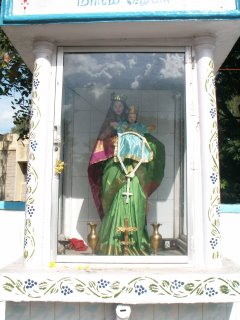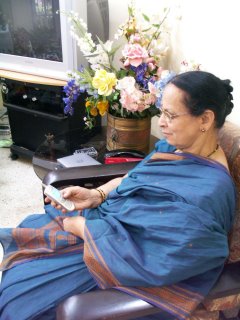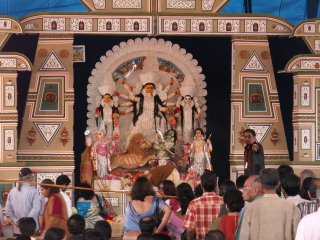
The diversity inherent to
India’s unified existence is manifest in the way major festivals are celebrated in different parts of the country. Navraatri, the nine day festival followed by the grand finale on the tenth day, called Vijaydashami are some of them. They are celebrated by Hindus all over
India, but it holds special significance to people in
North India, which is different from how it is perceived by Bengalis in the eastern regions of
India. This in turn is quite unlike the way that South Indians relate to this festival and celebrate it. I have attempted to explain some of these differences here, based on some of my own experiences in
Delhi and
Calcutta (where I grew up and spent most of my life until sometime back!) and now in
Bangalore. This piece is longish, because I’ve included some of the tales and legends that go with this season of festivals.
I shall start from the north of India. Here, the ten-day festival is called ‘Dussehra’. The nine-day celebration of Navraatri culminates in Vijay-Dashami (the victorious tenth day). It is believed that Lord Rama, after nine days of praying to Goddess Durga, the epitome of Shakti (strength / power), finally defeated Ravana on the tenth day and reunited with his wife, Sita. Thence the term ‘vijaydashami’. On this day, large effigies of Ravana, his son Indrajeet and Ravana’s brother Kumbhakarana are burnt, amidst lot of celebration and show of firecrackers. Actually large quantities of firecrackers are stashed in the cavities of these inflammable mammoth mannequins, before setting it on fire. Usually it is done in large, public grounds where many people gather to watch the grand display of firecrackers.
In Delhi, people gather in ‘Ramleela’ grounds to witness the fireworks and take part in celebrations. Of course there’s the issue of one’s personal safety, not just because of firecrackers, but also the boisterous crowds that sometimes can get out of hand! Beware of pickpockets, eve teasers and rabble rousers!
Now to go towards eastern India – West Bengal to be specific… This ten-day festival is seen as the time when Goddess Durga came down to earth and vanquished the demon, Mahishasura (the buffalo demon and you’ll see in a while why he is called thus). Legend has it that Mahishasura had become extremely powerful and had spread his reign of terror all over earth and the netherworld. He even had Lord Shiva’s boon that no man on earth, in heaven or the netherworld could vanquish him (he was too proud to ask that no woman should defeat him – and that was his undoing. What a dumb dude!)
Distraught by the asura’s growing powers, people prayed to the trinity – Brahma (the creator), Vishnu (the preserver) and Shiva (the destroyer) – to deliver them from this demon. It was then that the Gods approached Shiva’s consort, Goddess Parvati, who agreed to go down to earth and save her devotees as Durga (the Goddess of war – a malevolent aspect of Devi). The Gods began giving their weapons to Durga. With each weapon that she got, the ten-armed Goddess became more and more powerful. Not only the Gods, but even the goddesses (especially, Saraswati, Lakshmi and Kali) gave their powers and strength to her.
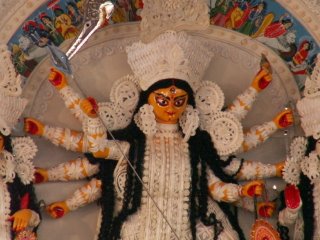 Armed with all these weapons and powers, Durga descended the earth, riding a ferocious lion. After nine days of battle, she killed the demon who had tried all his tricks on her. Right from changing his form to various animals, to creating ‘rakta-beeja’ (literally stands for the ‘bloody seed’. It was Mahishasura’s trick - quite a juvenile one if you ask me - whereby, he caused more and more demons to come to life with every drop of blood that Durga drew from him during the battle). Durga took Kali’s assistance to destroy the ‘rakta-beeja’ (Kaali is also considered another form of Parvati). On the tenth-day of the battle, the demon took the form of a buffalo (that should explain the buffalo-demon bit). Durga promptly decapitated the animal and thus killed Mahishasura. This tenth-day of Mahishasuramardini’s victory (Mahishasuramardini – slayer of Mahishasura, i.e. Durga) is celebrated by Bengalis as ‘Bijoya’.
Armed with all these weapons and powers, Durga descended the earth, riding a ferocious lion. After nine days of battle, she killed the demon who had tried all his tricks on her. Right from changing his form to various animals, to creating ‘rakta-beeja’ (literally stands for the ‘bloody seed’. It was Mahishasura’s trick - quite a juvenile one if you ask me - whereby, he caused more and more demons to come to life with every drop of blood that Durga drew from him during the battle). Durga took Kali’s assistance to destroy the ‘rakta-beeja’ (Kaali is also considered another form of Parvati). On the tenth-day of the battle, the demon took the form of a buffalo (that should explain the buffalo-demon bit). Durga promptly decapitated the animal and thus killed Mahishasura. This tenth-day of Mahishasuramardini’s victory (Mahishasuramardini – slayer of Mahishasura, i.e. Durga) is celebrated by Bengalis as ‘Bijoya’.
Marking the beginning of this ten day celebration is the ‘Mahalaya amavasya’ (Amavasya or the new moon; Mahalaya or the abode of Maha / Shiva). Every year there is a Mahalaya special on radio, broadcast by All India Radio, called Mahishasuramardini. It is a one and half hour programme, which starts at 4 am sharp, always. No Bengali’s Pooja is complete without listening to this Mahalaya special. You too can hear it on http://userfs.cec.wustl.edu/~sb3/Mahalaya.htm or download it at
http://www.badongo.com/file/1438353and http://d.turboupload.com/d/1005639/Mahalaya.wav.html
In Calcutta, where I spent all my childhood (and adolescence) people used to put up ‘pandals’ (tents / shamiana) all over the city with magnificent idols of Durga in the act of slaying Mahishasura. Accompanying Durga were others like Saraswati (the Goddess of learning and wisdom), Lakshmi (the Goddess of wealth), Ganesha (also the God of wisdom, but more popularly known as the remover of obstacles) and Kartikeya (Ganesha’s brother). There would be cultural programmes – music, dance, drama / skits -all through the night and people would be dressed in their best clothes making a beeline to various ‘pandals’.
We used to stay in Salt Lake. I remember how my parents, older sister and I would go visiting all Pandals in the area. In fact, my sister and I used to compete with our friends on who had seen more pandals in a day!
Apart from cultural programmes, ‘poojas’ are performed by priests all through the day. If it’s a neighbourhood pandal (and usually that’s what they are), everyone gets together and helps in cooking and the poojas. I remember that a Durga pandal was once constructed right outside our house and I could see everything going on inside. Most of the time, I could see only the purohit’s (priest) bottom, while he bent down at the Goddess’s feet! (Durga must’ve been impressed for sure, because she didn’t get to see the other angle of this guy that I saw!) But, there were other interesting things as well. All the aunties from our neighbourhood were there chopping vegetables, gossiping with each other. It was a great time to catch up on grapevine.
The most colourful part is the evening, when dance and drama sessions begin. I remember, all the young boys and girls from our ‘paaraa’ (block) would be there, showing off their skills (sometimes the lack of it!) But the best times were the ‘bhog’ (food), when all of us could hog to our heart’s content on everything, right from luchi-aloordom, khichidis to sweets!
On the last of the festival, i.e. ‘dashami’, all married Bengali women get together and play with the ‘sindoor’ (vermillion. It is worn only by married Hindu women on their foreheads). They smear sindoor all over each other – pretty much like what happens during ‘Holi’. Subsequently, there is some more Pooja and then the immersion of idols in the evening. All idols are usually immersed in the Hoogly (Ganga as it’s known in Calcutta) and that goes on till late hours of the night.
In the South of India, ‘Navraatri’ has a different hue. Although people worship Durga even here, prominence is not given to Durga idols or pandals. Rather, people exhibit all the dolls and (sometimes) toys in their homes. These dolls are neatly arranged and decorated on a series of raised platforms, which are made to look like stairs. Families visit each other’s homes and see how differently each household has show-cased its dolls. They could either be dolls from different parts of the country, or the world, or even dolls of Rama, Krishna and other Gods.
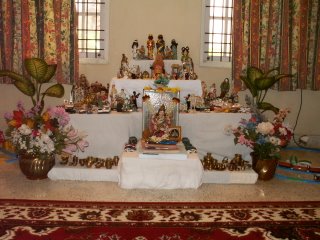 Actually, there is a legend behind these dolls and their display in the South. This was told to me by my sister-in-law, who heard it from someone and who in turn heard from someone else! The story might well be distorted beyond its original intent (like stories usually are!) Anyway, here is how it goes…. Long time ago, there was a man who left his home and wife and went to the Himalayas to meditate on Lord Shiva. Pleased by his devotion, Shiva appeared in front of this man after many years. Upon being asked for a boon, the man said that he and his wife wanted a child, since they were still childless. (Am sure Shiva must’ve wanted to say, “Like obvious dude! What else did you expect; when you were here gallivanting in the mountains and your poor wife was left out there alone?!)
Actually, there is a legend behind these dolls and their display in the South. This was told to me by my sister-in-law, who heard it from someone and who in turn heard from someone else! The story might well be distorted beyond its original intent (like stories usually are!) Anyway, here is how it goes…. Long time ago, there was a man who left his home and wife and went to the Himalayas to meditate on Lord Shiva. Pleased by his devotion, Shiva appeared in front of this man after many years. Upon being asked for a boon, the man said that he and his wife wanted a child, since they were still childless. (Am sure Shiva must’ve wanted to say, “Like obvious dude! What else did you expect; when you were here gallivanting in the mountains and your poor wife was left out there alone?!)
Of course Shiva refrained from that comment and granted him his boon. He also gave him a little pot with something in it for his wife (Yak butter? Snow-malt? Hmmm… can’t recall what it was for the life of me!). He asked him to not lay down the pot anywhere until he reached home.
And so our frost-bitten dude set off for home. On the way, he reached an ‘ashram’ (hermitage), where an old rishi (sage) asked him to rest. The man replied that he could not, because he was not supposed to lay down the pot which was for his wife. To cut a long story short, our snow-man stayed at the hermitage and the rishi asked him to marry his daughter. Now, a Brahmin’s wish is never refused (for fear of a curse I suppose. These guys dole out curses at the drop of a hat!) and so the chap married the dame. While he was at it, he also gave her that pot to drink (not smoke).
The newly-married wife gave birth to a son, shortly after which the polygamous guy popped it. As this little boy grew up, he demonstrated his skills as a gifted doll-maker. He made all kinds of dolls in clay and neatly arranged it all over the ashram. Once when he came of age, a king’s army (cannot recall which king this was and where his kingdom lay) came and asked the rishi to relocate the hermitage, because the king wanted to extend his headquarters close by (sounds pretty much like our politicians today, who shift the jhopdi-walas, because they want the land! Man! India’s corrupt political dudes have a lineage!) The rishi refused, enraging both the king and his army.
As was to be expected, the king’s army attacked the ashram. This was when all the thousands and thousands of little dolls that the boy had made over the years, came to life (reminds me of Tchaikovsky’s Nutcracker. Now I know where he got his inspiration from!). All the dolls transformed into soldiers and attacked the king’s army and defeated them. Thus was the ashram saved and everyone lived happily ever after.
So, this is how Navraatri, followed by Vijaydashami is celebrated in India. It’s similar in spirit - conquest of good over evil, of right over might and last but not least, of woman over man (*winks*). Yet it’s different in the way people celebrate – be it through effigies, or dolls or idols of gods.
I wish everyone a wonderful Navraatri, Dussehra and a ‘Shubho Bijoya’!
